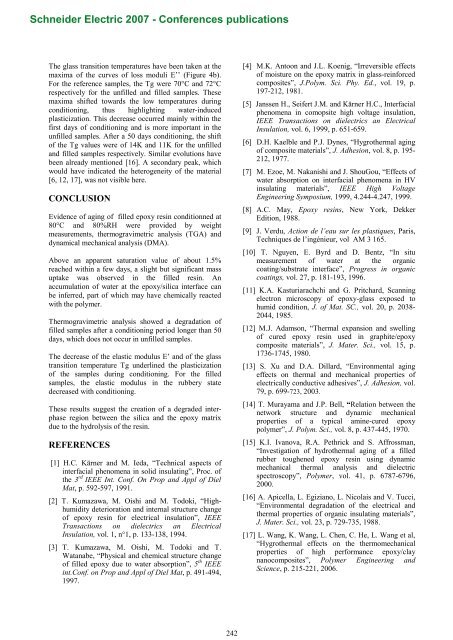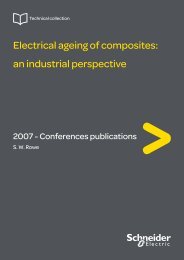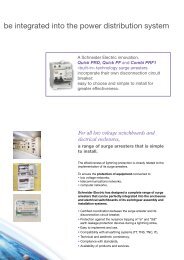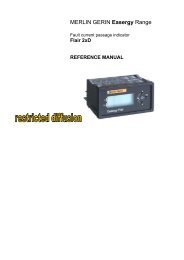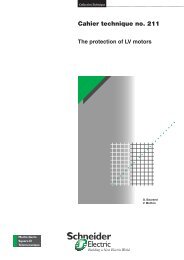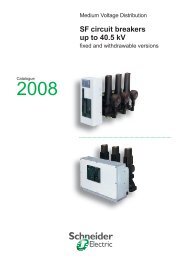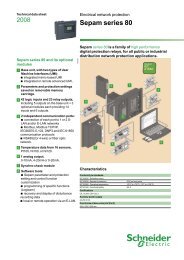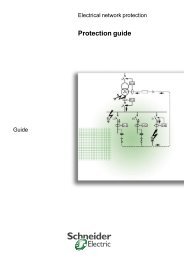Hygrothermal aging of a filled epoxy resin - Schneider Electric
Hygrothermal aging of a filled epoxy resin - Schneider Electric
Hygrothermal aging of a filled epoxy resin - Schneider Electric
You also want an ePaper? Increase the reach of your titles
YUMPU automatically turns print PDFs into web optimized ePapers that Google loves.
<strong>Schneider</strong> <strong>Electric</strong> 2007 - Conferences publications<br />
The glass transition temperatures have been taken at the<br />
maxima <strong>of</strong> the curves <strong>of</strong> loss moduli E’’ (Figure 4b).<br />
For the reference samples, the Tg were 70°C and 72°C<br />
respectively for the un<strong>filled</strong> and <strong>filled</strong> samples. These<br />
maxima shifted towards the low temperatures during<br />
conditioning, thus highlighting water-induced<br />
plasticization. This decrease occurred mainly within the<br />
first days <strong>of</strong> conditioning and is more important in the<br />
un<strong>filled</strong> samples. After a 50 days conditioning, the shift<br />
<strong>of</strong> the Tg values were <strong>of</strong> 14K and 11K for the un<strong>filled</strong><br />
and <strong>filled</strong> samples respectively. Similar evolutions have<br />
been already mentioned [16]. A secondary peak, which<br />
would have indicated the heterogeneity <strong>of</strong> the material<br />
[6, 12, 17], was not visible here.<br />
CONCLUSION<br />
Evidence <strong>of</strong> <strong>aging</strong> <strong>of</strong> <strong>filled</strong> <strong>epoxy</strong> <strong>resin</strong> conditionned at<br />
80°C and 80%RH were provided by weight<br />
measurements, thermogravimetric analysis (TGA) and<br />
dynamical mechanical analysis (DMA).<br />
Above an apparent saturation value <strong>of</strong> about 1.5%<br />
reached within a few days, a slight but significant mass<br />
uptake was observed in the <strong>filled</strong> <strong>resin</strong>. An<br />
accumulation <strong>of</strong> water at the <strong>epoxy</strong>/silica interface can<br />
be inferred, part <strong>of</strong> which may have chemically reacted<br />
with the polymer.<br />
Thermogravimetric analysis showed a degradation <strong>of</strong><br />
<strong>filled</strong> samples after a conditioning period longer than 50<br />
days, which does not occur in un<strong>filled</strong> samples.<br />
The decrease <strong>of</strong> the elastic modulus E’ and <strong>of</strong> the glass<br />
transition temperature Tg underlined the plasticization<br />
<strong>of</strong> the samples during conditioning. For the <strong>filled</strong><br />
samples, the elastic modulus in the rubbery state<br />
decreased with conditioning.<br />
These results suggest the creation <strong>of</strong> a degraded interphase<br />
region between the silica and the <strong>epoxy</strong> matrix<br />
due to the hydrolysis <strong>of</strong> the <strong>resin</strong>.<br />
REFERENCES<br />
[1] H.C. Kärner and M. Ieda, “Technical aspects <strong>of</strong><br />
interfacial phenomena in solid insulating”, Proc. <strong>of</strong><br />
the 3 rd IEEE Int. Conf. On Prop and Appl <strong>of</strong> Diel<br />
Mat, p. 592-597, 1991.<br />
[2] T. Kumazawa, M. Oishi and M. Todoki, “Highhumidity<br />
deterioration and internal structure change<br />
<strong>of</strong> <strong>epoxy</strong> <strong>resin</strong> for electrical insulation”, IEEE<br />
Transactions on dielectrics an <strong>Electric</strong>al<br />
Insulation, vol. 1, n°1, p. 133-138, 1994.<br />
[3] T. Kumazawa, M. Oishi, M. Todoki and T.<br />
Watanabe, “Physical and chemical structure change<br />
<strong>of</strong> <strong>filled</strong> <strong>epoxy</strong> due to water absorption”, 5 th IEEE<br />
int.Conf. on Prop and Appl <strong>of</strong> Diel Mat, p. 491-494,<br />
1997.<br />
[4] M.K. Antoon and J.L. Koenig, “Irreversible effects<br />
<strong>of</strong> moisture on the <strong>epoxy</strong> matrix in glass-reinforced<br />
composites”, J.Polym. Sci. Phy. Ed., vol. 19, p.<br />
197-212, 1981.<br />
[5] Janssen H., Seifert J.M. and Kärner H.C., Interfacial<br />
phenomena in comopsite high voltage insulation,<br />
IEEE Transactions on dielectrics an <strong>Electric</strong>al<br />
Insulation, vol. 6, 1999, p. 651-659.<br />
[6] D.H. Kaelble and P.J. Dynes, “<strong>Hygrothermal</strong> <strong>aging</strong><br />
<strong>of</strong> composite materials”, J. Adhesion, vol. 8, p. 195-<br />
212, 1977.<br />
[7] M. Ezoe, M. Nakanishi and J. ShouGou, “Effects <strong>of</strong><br />
water absorption on interfacial phenomena in HV<br />
insulating materials”, IEEE High Voltage<br />
Engineering Symposium, 1999, 4.244-4.247, 1999.<br />
[8] A.C. May, Epoxy <strong>resin</strong>s, New York, Dekker<br />
Edition, 1988.<br />
[9] J. Verdu, Action de l’eau sur les plastiques, Paris,<br />
Techniques de l’ingénieur, vol AM 3 165.<br />
[10] T. Nguyen, E. Byrd and D. Bentz, “In situ<br />
measurement <strong>of</strong> water at the organic<br />
coating/substrate interface”, Progress in organic<br />
coatings, vol. 27, p. 181-193, 1996.<br />
[11] K.A. Kasturiarachchi and G. Pritchard, Scanning<br />
electron microscopy <strong>of</strong> <strong>epoxy</strong>-glass exposed to<br />
humid condition, J. <strong>of</strong> Mat. SC., vol. 20, p. 2038-<br />
2044, 1985.<br />
[12] M.J. Adamson, “Thermal expansion and swelling<br />
<strong>of</strong> cured <strong>epoxy</strong> <strong>resin</strong> used in graphite/<strong>epoxy</strong><br />
composite materials”, J. Mater. Sci., vol. 15, p.<br />
1736-1745, 1980.<br />
[13] S. Xu and D.A. Dillard, “Environmental <strong>aging</strong><br />
effects on thermal and mechanical properties <strong>of</strong><br />
electrically conductive adhesives”, J. Adhesion, vol.<br />
79, p. 699-723, 2003.<br />
[14] T. Murayama and J.P. Bell, “Relation between the<br />
network structure and dynamic mechanical<br />
properties <strong>of</strong> a typical amine-cured <strong>epoxy</strong><br />
polymer”, J. Polym. Sci., vol. 8, p. 437-445, 1970.<br />
[15] K.I. Ivanova, R.A. Pethrick and S. Affrossman,<br />
“Investigation <strong>of</strong> hydrothermal <strong>aging</strong> <strong>of</strong> a <strong>filled</strong><br />
rubber toughened <strong>epoxy</strong> <strong>resin</strong> using dynamic<br />
mechanical thermal analysis and dielectric<br />
spectroscopy”, Polymer, vol. 41, p. 6787-6796,<br />
2000.<br />
[16] A. Apicella, L. Egiziano, L. Nicolais and V. Tucci,<br />
“Environmental degradation <strong>of</strong> the electrical and<br />
thermal properties <strong>of</strong> organic insulating materials”,<br />
J. Mater. Sci., vol. 23, p. 729-735, 1988.<br />
[17] L. Wang, K. Wang, L. Chen, C. He, L. Wang et al,<br />
“<strong>Hygrothermal</strong> effects on the thermomechanical<br />
properties <strong>of</strong> high performance <strong>epoxy</strong>/clay<br />
nanocomposites”, Polymer Engineering and<br />
Science, p. 215-221, 2006.<br />
242


